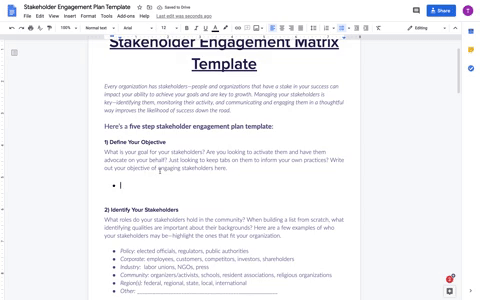In the realm of public affairs and government relations, managing relationships with stakeholders is not just a business priority — it’s a strategic imperative. Whether you’re securing support for a legislative initiative, influencing regulations, or opposing a proposed policy, effective stakeholder engagement can be the deciding factor in your success. One of the most effective tools for navigating these relationships is a stakeholder engagement matrix.
This guide will explain the importance of stakeholder engagement, how to use a stakeholder engagement matrix, and how to leverage best practices to ensure your success in government affairs.
What is a Stakeholder Engagement Matrix?
A stakeholder engagement matrix is a strategic tool for classifying and assessing stakeholders based on their level of influence and interest in your policy or initiative. They allow you to prioritize and tailor your engagement strategies, ensuring that you focus your efforts and attention on 1) the most influential and 2) the most interested stakeholders. This ensures that your time is spent strategically to achieve your goals.
In government affairs, stakeholders might include policymakers, advocacy groups, regulatory bodies, community leaders, and the general public. By mapping these groups according to their influence and interest, your team can develop more effective outreach and advocacy strategies that resonate with each audience.
This process of categorizing and grouping stakeholders is often called stakeholder mapping.
Steps to Build an Effective Stakeholder Engagement Matrix
1. Define Your Objectives
Start by clarifying the goals of your engagement efforts. Are you seeking to build coalitions in support of legislation? Inform stakeholders of a new regulatory requirement? Activate stakeholders to advocate on your behalf? Clearly defining your objectives will guide your strategy throughout the process.
2. Identify Your Stakeholders
Consider the full spectrum of stakeholders who can impact or be impacted by your initiative. Stakeholders in government affairs typically include:
- Policymakers: Elected officials, regulators, and public authorities
- Corporate Entities: Business associations, investors, competitors
- Advocacy and Industry Groups: Labor unions, NGOs, think tanks
- Community Leaders: Organizers, activists, and resident associations
3 .Determine Current Engagement Level
Next, categorize stakeholders into groups based on their stance on the issue:
- Champion: Supports your initiative
- Neutral: Neither supports nor opposes.
- Detractor: Actively opposes your initiative.
Alternatively, you can adopt an approach from the Project Management Institute’s PMBOK framework, classifying stakeholders as:
- Unaware: Stakeholders who are not aware of the project.
- Resistant: Stakeholders who oppose the project.
- Neutral: Stakeholders who are neither supportive nor opposed.
- Supportive: Stakeholders who are positive but not leading.
- Leading: Stakeholders who are actively driving the project forward.
4. Prioritize Stakeholders Based on Influence and Interest
Once identified, stakeholders can be categorized into four groups based on their level of influence (how much power they have to affect the outcome of your initiative) and interest (their level of investment in your issue):
- High Influence/High Interest: These stakeholders should be closely managed and engaged throughout the process.
- High Influence/Low Interest: Keep these stakeholders satisfied and informed, as their influence could be pivotal.
- Low Influence/High Interest: Keep these stakeholders informed, as they can help mobilize public opinion.
- Low Influence/Low Interest: Provide basic updates, but minimal engagement is required.
5. Assemble Your Toolkit for Engagement
Based on the needs of each stakeholder category, use monitoring, communication, and engagement tools to identify the most effective strategy for each category. For example:
- Monitoring: Track conversations and mentions using tools like Google Alerts or Quorum to understand what stakeholders are saying about your initiative.
- Communication: Tailor your outreach strategy based on the stakeholder’s region or interests. This could include personal outreach via email or phone, public statements, or targeted messaging through social media.
- Engagement: Use tactics like town halls, private briefings, or public advocacy campaigns to engage stakeholders more deeply.
After completing these steps, you’ll have a comprehensive list of stakeholders categorized by their interest, influence, and current engagement level, and you’ll also have an effective outreach strategy for each group, and can start engaging with your high-priority targets.
Real-World Example: Government Affairs Initiative
Let’s consider an initiative focused on gaining support for a new environmental regulation. Stakeholders might include policymakers, advocacy groups, businesses, and the general public. Your engagement matrix might look like this:
| Stakeholder | Current Level | Desired Level | Interest | Influence |
| Key Policymakers | Neutral | Supportive | High | High |
| Issue Advocacy Groups | Leading | Leading | High | Medium |
| Large Corporations | Resistant | Neutral | Medium | High |
| Local Governments | Supportive | Leading | High | Medium |
| General Public | Unaware | Supportive | Low | Low |
In this case:
- Key Policymakers: These are influential decision-makers whose support is crucial. Your strategy would include regular briefings, policy papers, and direct outreach to shift them from neutral to supportive. Since they have high interest and influence, they should be a top target.
- Issue Advocacy Groups: As these groups are already engaged and supportive, keep them involved through coordinated actions like joint press releases, social media campaigns, or public events to showcase their backing.
- Large Corporations: These businesses may resist the regulation due to financial concerns. You might try to convert them from resistant to neutral by demonstrating how the regulation benefits them or offering insights into compliance incentives. Since they have high interest and influence, they should be a top target.
- Local Governments: As natural allies, offer them recognition for their early support and provide assistance for continued support.
- General Public: Public education campaigns through social media and town halls can increase awareness, helping to mobilize grassroots support for the initiative. In this example, the general public is a lower priority compared to lawmakers and corporations.
Overcoming Common Challenges in Stakeholder Engagement
Effective stakeholder engagement in government affairs often involves navigating a series of challenges, including:
- Limited Resources: Not all stakeholders can receive the same level of attention. Prioritize engagement based on your matrix, focusing on those with the highest influence and interest.
- Resistance to Change: Some stakeholders may resist your initiative, especially if they perceive it as a threat to their interests. Providing evidence-backed data and demonstrating mutual benefits can help shift their stance from resistant to neutral or supportive.
- Political Gridlock: Sometimes, moving people is easier than moving policies. When that’s the case, you may need to focus on education rather than policy changes.
Best Practices for Stakeholder Engagement in Government Affairs
- Regularly Update Your Matrix: Stakeholder interests and influence can shift over time. As political landscapes change or new information comes to light, it’s essential to update your matrix and adjust your strategies accordingly.
- Leverage Technology: Tools like Quorum help streamline your monitoring, communication, and engagement efforts. By centralizing your stakeholder management process, you can ensure that no key contacts slip through the cracks.
- Tailor Communication Strategies: Different stakeholders respond to different methods of communication. While policymakers may prefer formal briefings, advocacy groups might be more engaged through public events or social media campaigns. Customize your outreach based on stakeholder preferences.
In government and public affairs, a well-crafted stakeholder engagement plan can be the difference between success and failure. By utilizing a stakeholder engagement matrix, you can prioritize and strategize your outreach efforts,



